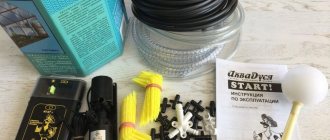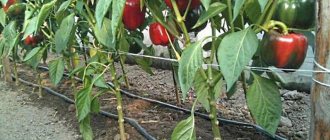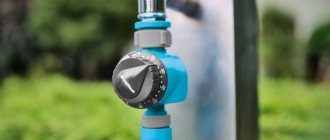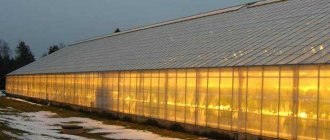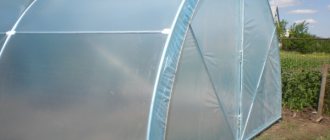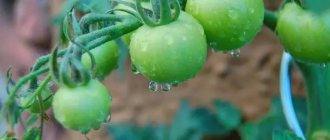When choosing which automatic watering system to install for their greenhouse, gardeners first of all pay attention to its price. On the contrary, we recommend that you first pay attention to the size of the greenhouse and decide on the vegetables that you will grow. The efficiency of a particular system largely depends on these factors. The benefits of automatic watering of greenhouses are quite extensive. Firstly, you will be able to devote more time to other things than rushing back and forth with a watering can and watering the plants. Secondly, there will never be any doubt whether you have topped up or overwatered the plant. Isn't it great? Definitely a useful item for any gardener. Whichever automatic greenhouse watering machine you choose, you should remember that it must be connected to a water tank - a barrel, a box, a bathtub. Only warm water, heated at least under the sun, should be supplied to the greenhouse. In our review today, we will look at which automatic watering system is best for a greenhouse, where to buy it, and what pros and cons we should expect.
Photo: https://homeli.ru
OGO-Rodnik-1
Photo: https://beru.ru/
This device measures soil moisture and turns on watering if necessary. In rainy weather, there will be no watering, and in dry weather, watering will be more frequent, which allows you to use water sparingly and effectively water the plants. The advantage of this Russian development is its low price, ease of installation and operation. The OGO-Rodnik system has the ability to interface with most drip irrigation kits, sprinkling systems and home-made irrigation components sold on the market.
Automatic watering OGO-Rodnik-1
Advantages:
- constant soil monitoring
- economical water consumption
- battery operation
Flaws:
- not detected
Where and at what price are they sold?
Devices of various types, with a pressure power of 13 or over 35 m, are sold in various stores specializing in the supply of technical equipment:
- 220 volt;
- Bison;
- Karcher;
- Makita;
- Vortex;
- Teplotek South;
- Tiu.ru;
- Ozone, Wildberries.
Prices in most stores correspond to the standard - low-power models can be purchased from 2000 rubles. Powerful devices cost 4,000 – 10,000 rubles. You can also purchase a ready-made irrigation system at a price of 5,000 rubles.
Water strider
Photo: https://beru.ru/
Water strider" is a drip irrigation system for plants in greenhouses and open beds. It connects to a barrel or summer water supply. Flexible hoses are located on the beds; a dropper is connected to each sprout, which ensures uniform and economical moistening, eliminating soil washing out and water getting on the leaves of the plants. The water strider works without electricity. The set includes a convenient automatic controller, with which you can set the interval and duration of water supply. The timer allows you to select the exact time of continuous watering from 2 minutes to 2 hours with a specified frequency. The basic length of the irrigation system is 4 meters, the additional extension insert is 2 meters. The hoses are attached to the water supply or barrel using an adapter with a nut. To prevent dirt from getting into the hose, the design includes a mechanical water purification system.
Will Drip irrigation set Water strider
Advantages:
- clear design
- ease of use
- acceptable price
Flaws:
- flimsy plastic
Step-by-step instructions on how to calculate productivity
A simple formula using which you can calculate the overall system performance and the required pump pressure: Ntr = Ngeo + Nloss + Nfree, where :
- Ntr – indicator of the required pressure;
- Ngeo – height difference between the point where the pump will be installed and the irrigation zone;
- Nloss – the sum of possible water losses;
- Nsvob - free water pressure. On average, to be able to use the pump, a value of 15-20 is used.
To calculate the Nloss indicator, you need to use the table, which can be downloaded here.
Approximate calculation for drawing water from a well:
- Nfree – 20 m (standard number);
- water level in the well – 10 m + height difference – 5 m = Нgeо = 20 m;
- Nloss (according to the table) – 30 m.
Ntr= 20 m+30 m+ 20 m = 70 m. So, for normal water supply you will need a pressure of at least 70 m.
Knowing how many liters per minute are supplied to water the garden, you can determine the required water pressure . To calculate, just use the figure below and select the water supply rate (l/min) and pump type (70/50 or 60/45). For example, for a 60/45 pump with a water supply of 60 l/min, a pressure of 45 m will be sufficient.
AKP-6
Photo: https://beru.ru/
The AKP OGO-Rodnik kit is ideal for creating an automated drip irrigation system in greenhouses and greenhouses, beds connected to a tank or barrel installed 1-2 m above the irrigation level. It consists of an electric faucet with a built-in control system, a soil moisture sensor and a power supply from AA batteries, a drip irrigation kit with all the necessary fittings, designed for an area of 3x4 - 3x6 m. The humidity sensor constantly monitors soil moisture; if there is not enough moisture in the soil for the plant, the tap will open and watering will begin.
Automatic watering kit AKP-6
Advantages:
- acceptable price
- good functionality
- long service life
Flaws:
- not detected
Briefly about the main thing
Automatic watering in a greenhouse is a real and not too costly rationalization that allows you to free up time and hands for other work and establish systematic and rational care of plants, regardless of the health status, capabilities and employment of people.
Setting up automatic watering requires:
- site planning;
- calculations of the quantity and range of necessary equipment;
- installation of a plumbing system inside the greenhouse;
- installation of automation equipment.
But after completing the work, it is enough to connect the system and just monitor its condition.
AUTO-WATERING-25
Photo: https://beru.ru/
The AUTOPOLIV-2 drip irrigation system using tape for up to 50 m of beds is what is required to ensure adequate soil moisture around the grown plants. It can be used to ensure proper watering in greenhouses or exposed soil areas. The set includes good fittings and an emitter tape for drip irrigation, which consists of tubes with thin walls, hollow inside with built-in droppers, located at a distance of 30 meters from each other.
AUTO-WATERING-25
Advantages:
- acceptable price
- good functionality
- clear design
Flaws:
- not detected
Types of hoses
The industry produces several types of irrigation hoses, which differ in their strength, flexibility, resistance to bending and price.
Typically, the selection criterion is a compromise between the characteristics of products and their price.
Hoses are divided into:
- intakes, which are mounted between the water source and the container;
- irrigation systems, through which water is supplied to the plants;
- tapes providing drip supply of liquid.
You need to make the right choice among such a variety of hoses Source meme-arsenal.com
GA-3199(Beetle)
Photo: https://beru.ru/
Automatic timer for irrigation, irrigation controller and, including timer for water supply GA-319 (Beetle). The pressure in the system is from 0.2 to 6 atm, this timer has a membrane valve, which cannot but please any summer resident. Powered by two AAA batteries. Connecting dimensions: inlet 3/4HP, outlet 3/4HP with quick click screw-on adapter (quick release for hose). The front panel is closed with a translucent threaded lid with a rubber gasket. Colors may vary from those shown.
automatic watering GA-3199 (Beetle)
Advantages:
- ease of use
- affordable price
- reliable fastenings
- practicality
Flaws:
- no batteries included
Famous brands, approximate prices
A watering pump is purchased for more than one year, so it is better to purchase a reliable unit from a well-known brand than to regularly repair a cheap model.
Popular brands of pumping equipment are on everyone's lips. These are the German Karher (Kärcher) AL-Ko (Alco) and Gagdena (Gardena), as well as the Italian brand Pedrollo (Pedrollo). They do not cause trouble to owners either during operation or during service.
A barrel pump for irrigation from these companies can be purchased at a price of 5,500 rubles (lifting height 11-14 meters, capacity 60 l/min). Surface and submersible pumps from German manufacturers are sold at prices starting from 6,000 rubles. For drainage installations of low and medium power you will have to pay from 4 to 9 thousand rubles
A lot of positive reviews apply to domestic watering pumps Dzhileks, Malysh and the Belarusian Rucheyk. At a very affordable price, they are reliable and easy to use. Barrel pumps Malysh and Rucheek can be purchased at prices starting from 1,500 rubles. Submersible vibration pumps from these companies are not much more expensive (RUB 1,500-2,000).
Prices for domestic submersible pumps (centrifugal) start at 5,000, and drainage units can be purchased for an average of 4-5 thousand rubles.
Dachas are mainly located in places where there is no trace of a central water supply. Everyone gets water as best they can: some have a river, pond or lake nearby, some drill a well or dig a well. And, in order not to extract and carry water from there manually, it is better to get a pump.
The pump is selected depending on the conditions, or more precisely, on what source of water supply you will use. If your site is on the shore of a reservoir, or you have dug a well and the water in it is not deep, then you can use a surface pump. And if you are so “lucky” that there are no open sources of water nearby, then the only way out is to extract it from great depths, that is, from a well. And also collect it in a barrel and place it under the drain. In this case, you need to buy another pump: submersible or barrel.
Watering a garden nearby a pond
A vegetable garden next to a pond is good in all respects: both for providing crops in the garden beds and for relaxation. And to have more time free from caring for these very beds, it is better not to carry water in buckets, but buy a water pump for irrigation. The main thing in this matter is the right choice. Definitely, you need a surface pump, and they come in 2 types:
- vortex;
- centrifugal.
So which one is it? Main:
- so that the weight and dimensions are small, because you will have to carry it;
- so that it can be easily installed;
- easy to exploit.
Vortex pump
This type of water pump for watering a garden is the cheapest. Works if:
- there is no sand, algae, or silt in the water that it will pump;
- The depth of lowering of the water intake hose is very small.
Advantage: the pressure it creates is 3 to 7 times greater than that of a centrifugal one, with other parameters being equal.
- The efficiency is only 45%;
- It is very noisy when it works.
Centrifugal pump
The operating conditions of the centrifugal pump are as follows:
- there may be impurities in the pumped water, but small ones;
- immersion depth of the water intake hose - no more than 9 m;
- small air pockets in the hose are not a problem;
- unlike vortex, it is multi-stage.
Here is an example: surface centrifugal water pumps for irrigation Agidel M:
- working position - vertical;
- sucks up water from a maximum depth of 8 m;
- pumps 2.9 cubic meters per hour;
- head 22 m;
- weighs 6 kg.
Or another pump for irrigation Karcher (Kärcher). Depending on the model, it can pump up to 4.3 thousand liters in 1 hour, and raises water up to 70 meters. It has good characteristics. You can connect not one, but several hoses to it at the same time - the working pressure is quite enough for this. The big advantages are:
- Availability of automation.
- Watering time can be programmed;
- Electronic remote control;
- Availability of filter and air valve.
Another important thing is this: if you buy a pump, pay attention to its body. The best material for the case:
- cast iron;
- stainless steel;
- plastic.
Signor Tomato
Photo: https://beru.ru/
New for 2022! Definitely deserves a place in our top of the best automatic watering systems. The Signor Tomato system with a timer is capable of watering plants with water up to 8 programs! It runs at the frequency you set for it. Water for a period not exceeding 2 hours. Using this kind of watering can significantly simplify the task of fertilizing and at the same time protecting your pets. In contrast to complex computer systems, the operation of Signor Tomato 8 programs is based on the use of 2 standard batteries. The turnkey automatic watering system is placed in two boxes. The device is easy to use and designed for self-installation.
Signor Tomato Drip Irrigation Set
Advantages:
- ease of use
- long service life
Flaws:
- high price
- short hose
Submersible pump
This type of system works directly in water. There is a centrifugal and vibration unit. The first option is considered more preferable. However, you must buy a filter for it. The unit is installed directly on the water intake hole.
To pump out clean water without small particles, it is better to use a vibration pump. In terms of price, it will be significantly cheaper. Submersible installation can be installed using any method. The main thing is that the water that is pumped helps cool the engine. If the installation is carried out correctly, then even during prolonged operation the engine will not overheat.
Many models have a float switch. It is designed to minimize the risk of breakage. When the liquid level drops below the set level, the pump automatically turns off.
Main advantages:
- there is practically no noise during operation;
- no overheating;
- the unit functions perfectly with partial immersion;
- is compact;
- ease of installation.
Minuses:
- you need good insulation of the electrical cable;
- for repairs, the installation must be removed from the barrel;
- high price compared to surface devices.
Polivchik-64
Photo: https://beru.ru/
The Polivchik 64 drip irrigation system is designed to automatically supply water to the root zone of plants. Has 64 drippers, allowing you to water 64 plants at the same time. The included timer allows you to program 16 programs that can be executed simultaneously, which makes it possible to create flexible watering settings for the week. The watering timer runs on 2 batteries, which lasts for the entire irrigation season. The duration of one watering cycle is from 1 minute to 2 hours. The drip irrigation system is ideal for summer residents who come to their dacha on weekends.
Polivchik-64
Advantages:
- presence of 64 droppers
- easy to install
- acceptable price
Flaws:
- not detected
Design of irrigation systems
All smart greenhouses include the same parts that can perform several functions. Often the composition of different prefabricated systems differs only in a couple of unique components. Rain, underground and drip irrigation systems for greenhouses are assembled from the following similar parts:
- Source. Its role is played by a tank, well, borehole, standard household water supply or any large-capacity reservoir. It is important to monitor the temperature of the water supplied to the plants: it must correspond to that of the environment.
- Pump. A device that will pump water from a stationary tank or well. The well and water supply often have their own water supply; to connect to them you need to purchase a reducer. This module will limit excessively high pressure at specified sources so that there is no harm to piping, sprinklers or plants.
- Filter. Often not included as standard with a spot irrigation system. This module will limit the entry of debris into the pipes and purify the water from heavy impurities. There are coal, paper and mesh. Cleaning will help avoid premature failure of the line and a decrease in pressure inside the system.
- Solenoid valves. An automatic tap that blocks and unlocks the water supply based on a signal from the controller.
- Timer (controller). This part helps the network operate in semi-automatic mode and minimally depend on human intervention. Supplementing the controller with soil and air humidity and temperature sensors will make the greenhouse completely autonomous. When the timer or controller is triggered, a signal is sent to the valves, which shut off or open the water supply and turn on ventilation.
- Highway. The main part of greenhouse irrigation. Pipes should be selected according to the type and scale of the system used. Thus, for micro-sprinkling irrigation, a line made of lightweight polycarbonate is ideal. To increase reliability, it is better to provide pipes with supports. In addition to polycarbonate, polypropylene lines, steel (stainless steel), metal-plastic, and PVC are manufactured.
Automatic watering system design
Automatic water supply equipment
A dosed supply of liquid to plants according to a certain schedule or at a given humidity will help to grow a higher quality crop. The signal to the taps comes from a controller: sensors or timer. Their presence helps to save water, avoid exceeding the permissible level of soil moisture, and compensate for changes in the amount of moisture after rains.
A timer is the simplest electronic or electromechanical device for controlling water consumption. It cannot fully automate the irrigation process inside the greenhouse and requires supervision. So, after rain, when the soil is saturated with moisture, the timer will continue to signal the taps to open, which can destroy the plants by oversaturating the soil with water. The cost of the simplest model is from 1000 rubles.
Irrigation system timer
The controller, which has humidity and temperature sensors, can operate automatically without human intervention. The cost of the sensor is from 2000 rubles. The best models are equipped with remote control and sensors that take into account the following indicators:
- Pressure inside the line. If the pipes are clogged, the controller will not allow them to break. The barometer may detect excess pressure and will not signal the valves to open.
- Humidity of air, soil. The controller can maintain this indicator inside the greenhouse at a level specified by the user. Indicators are taken using submersible or mounted sensors.
- Temperature. If the greenhouse is equipped with windows with electromechanical closers, the controller will use them to regulate the temperature.
Water storage tank
Water reservoir in the greenhouse
For irrigation, it is better to use settled or rainwater from a special large reservoir. There it will warm up to ambient temperature, as plants need. You can also add liquid fertilizers or fertilizers, which will make the water more nutritious and beneficial for plants. Three holes need to be made in the tank:
- Upper. Located at the very top. Through it, the tank is filled with running water.
- Average. It is located just above the bottom so that when pumping water through the valve, debris is not sucked in along with the liquid.
- Lower. It is necessary for emergency draining of water or getting rid of debris that accumulates over time at the bottom of the tank.
Pumps and filters
These elements are directly responsible for supplying water to plants. The drip irrigation pump has the following selection criteria:
- Automatic control. The ability to connect a pump to sensors or a timer is an important condition for irrigation automation.
- Power. Installing a pump capable of creating high pressure is not practical for a network with a short total pipe length. The required power should be calculated separately.
- Resistance to aggressive chemical compounds. Allows the use of liquid fertilizers when feeding plants through a tank.
- “Soft start” is an important function of the pump. A sudden surge in pressure can seriously damage or disable valves, sprinklers, and internal line pressure sensors.
Pump design
Filters help rid water of foreign impurities or debris, which can lead to damage to drip dispensers, sprinklers, and tapes. The element is placed immediately after the water supply valve from the tank. There are the following types of modules:
- Reticulate. Does not reduce the pressure inside the system, but does not filter small particles well. Recommended for installation on small irrigation networks.
- Disk. Surpasses the mesh filter in terms of filtration.
- Bulk. Used in the construction of large-scale irrigation networks. The filter element is easily replaced when it becomes dirty.
GARDENA
Photo: https://beru.ru/
Kit for micro-drip irrigation in a greenhouse Gardena 01373-20.000.00 is an excellent helper for watering vegetables in your greenhouse. The assembled kit is a watering system for vegetables that require root irrigation (tomatoes, eggplants, peppers). Designed for a greenhouse with an area of up to 24 sq.m. Possibility of installing additional devices to ensure a fully automated watering process.
GARDENA 1373-20
Advantages:
- excellent quality
- long service life
- ease of assembly
Flaws:
- high price
Let's sum it up
Whatever pump you choose, it will definitely make the watering process easier. You can easily and comfortably water your garden. At the same time, you will save your time and nerves.
Varieties of barrel pumps are extremely easy to operate and take up very little space. When choosing a model, it is important to pay attention to the engine power and technical characteristics that will meet your individual requirements.
Source KPK-24
Photo: https://beru.ru/
Drip tape Istok KPK-24, a durable product that will last for many years. If possible damage occurs, it can be easily repaired. The nominal water flow rate through the dropper is 1.4 liters per hour. The droppers are located at a distance of 30 cm from each other, the irrigation diameter of one dropper is also 30 cm, which ensures watering in a continuous line. To prevent the drip tape from moving away from the plant roots when cultivating the soil, it is recommended to secure it to the ground without squeezing the flow of water. The level of technology for laying is extremely high; it can be combined with sowing a large number of seeds.
Istok Drip irrigation set KPK-24
Advantages:
- acceptable price
- good equipment
- long service life
Flaws:
- not detected
Bug
Photo: https://beru.ru/
And our review ends with the Zhuk drip irrigation set. This device is connected to the water supply system. It is equipped with an electric timer and is excellent for watering flora that like “cold” watering - radishes, carrots, beans and other plants. Suitable for watering alpine slides. Water for irrigation comes directly from the water supply at the dacha. The timer controls the water supply.
Beetle Drip Irrigation Set
Advantages:
- excellent equipment
- acceptable price
- easy to assemble
- long service life
Flaws:
- not detected
The best automatic drip irrigation for a greenhouse
Photo: https://vasha-teplitsa.ru
More recently, only the most skilled gardener could afford drip irrigation systems, who could select hoses and fasteners, calculate the length, and make some kind of holes. But today in stores you can choose any system to suit your taste and budget. Let's consider only options for greenhouses.
The line of drip systems called AquaDusya includes several different options. For example, the AquaDusya Water Tar set can only be used if you have a central water supply, since water must flow through the hoses under pressure. Also, when watering, it is worth considering that it will be cold. The system is equipped with a timer installed directly on the tap. It runs on batteries, so you'll have to make sure you always have a couple of replacement ones on hand. But the AquaDusya+60 kit can also be connected to a barrel, with only one condition - it must be installed at a height of at least 1 m to create pressure in the hoses. The advantages of this system: on sunny days, the water in the barrel heats up, so it can be used for capricious heat-loving plants. There are no additional devices in it, which is why it costs significantly less.
It would also be permissible to consider the Gardena micro-drip irrigation system, which includes a whole line of products for various purposes. But we are only interested in the system for greenhouses. The kit includes a basic, but despite this, quite an extensive set of elements from which you can assemble an irrigation system for a greenhouse of no more than 10 m2. The price for such a set of this brand is quite expensive. There is also an excellent quality Karcher drip irrigation system. I would like to emphasize that the kit is basic, that is, you will need to purchase additional elements for it: a timer, if you want to make the system automatic; hoses, if suddenly the length is not enough; Well, then progressively - tees, plugs, droppers, etc. But at the same time, its price is already affordable. Is it worth it? It's up to you to decide.
And with this our top comes to an end. We tried to highlight the 3 best systems from the top 10, automatic drip irrigation systems for your greenhouses. We hope that we were able to help you and provide you with all the information on this segment in some detail. Good luck!
#Top 10
Read us first - add the site to your favorite sources.
Add a comment
{"commentics_url":"\/\/express-novosti.ru\/comments\/","page_id":1467475,"enabled_country":false,"enabled_state":false,"state_id":0,"enabled_upload": false,"maximum_upload_amount":3,"maximum_upload_size":5,"maximum_upload_total":5,"securimage":true,"securimage_url":"\/\/express-novosti.ru\/comments\/3rdparty\/securimage\ /securimage_show.php?namespace=cmtx_1467475″,”lang_error_file_num”:”\u041c\u0430\u043a\u0441\u0438\u043c\u0443\u043c %d \u0444\u0430\u0439\u043b\u043e\ u0432\u043c\u043e\ u0436\u0435\u0442 \u0431\u044b\u0442\u044c \u0437\u0430\u0433\u0440\u0443\u0436\u0435\u043d\u043e.","lang_error_file_size":"\u041f\u043e \u0436\u0430\u043b\ u0443\u0439\u0441\u0442\u0430, \u0437\u0430\u0433\u0440\u0443\u0437\u0438\u0442\u0435 \u0444\u0430\u0439\u043b \u0440\u0430\ u0437\u043c\u0435\u0440\u043e \u043c \u043d\u0435 \u0431\u043e\u043b\u0435\u0435 %d MB.","lang_error_file_total":"\u041e\u0431\u0449\u0438\u0439 \u0440\u0430\u0437\u043 c\u0435\u0440\ u0432\u0441\u0435\u0445 \u0444\u0430\u0439\u043b\u043e\u0432 \u0434\u043e\u043b\u0436\u0435\u043d \u0431\u044b\u0442\u044c \ u043d\u0435\u0431\u043e\u043b\ u0435\u0435 %d MB.","lang_error_file_type":"\u041c\u043e\u0436\u043d\u043e \u0437\u0430\u0433\u0440\u0443\u0436\u0430\u0442\u044c \u0442\u0 43e\u043b\u044c ""lang_text_loading":" u0437\u043a\u0430 ..","lang_placeholder_state":"\u0420\u0435\u0433\u0438\u043e\u043d","lang_text_country_first":"\u0421\u043d\u0430\u0447\u0430\u043b\u0430 \u0432\u044b\u04 31\u0435 \u0440\u0438\u0442\u0435 \u0441\u0442\u0440\u0430\u043d\u0443″,”lang_button_submit”:”\u0414\u043e\u0431\u0430\u0432\u0438\u0442\u04 4c","lang_button_preview":" \u041f\u0440\u0435\u0434\u0432\u0430\u0440\u0438\u0442\u0435\u043b\u044c\u043d\u044b\u0439 \u043f\u0440\u043e\u0441\u043c\u 043e\u0442\u0440″,”lang_button_remove ":"\u0423\u0434\u0430\u043b\u0438\u0442\u044c","lang_button_processing":"\u041f\u043e\u0434\u043e\u0436\u0434\u0438\u0442\u0435..."}
What does water pressure mean?
Pressure is the height or distance to which water is supplied. This value is measured in meters. The important thing is that the pressure and performance of the apparatus at the end point remain unchanged. At the same time, the meaning of vertical and horizontal feed is completely different. The ratio between them will be 1:10. The pressure in a vertical position will be 10 times less. For example, the pump’s passport says that its pressure is 10 meters. This refers to the value in a vertical position. Based on this, the horizontal water supply of the pump is carried out over 100 meters.
Next, we will consider in detail how to choose a unit. Let's give another example. The container is located at a depth of one and a half meters underground. The length of the area that is planned to be irrigated is 35 meters. First of all, you need to understand that there are two parameters. The first indicates the vertical net pressure, and the second (horizontal) is reduced by 10 times.
Based on these data, we calculate the required pressure of the pumping unit: 1.5 + 3.5 = 5 m. It is important to take into account possible losses of water when moving it. After all, during the retraction and rotation of the hose, about 20 percent of the pressure is lost. It turns out: 35x0.2=7 m. Now let’s summarize: 5+7=12 m.
It is recommended to add an additional 10 percent to this value. This will be the so-called reserve. The end result will be a minimum of 13.2 meters.
